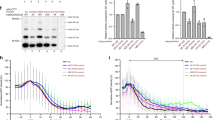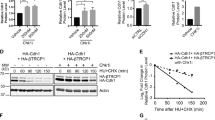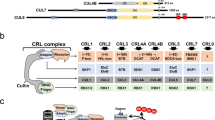Abstract
Cell-cycle transitions are driven by waves of ubiquitin-dependent degradation of key cell-cycle regulators. SCF (Skp1/Cullin/F-box protein) complexes and anaphase-promoting complexes (APC) represent two major classes of ubiquitin ligases whose activities are thought to regulate primarily the G1/S and metaphase/anaphase cell-cycle transitions, respectively1,2. The major target of the Skp1/Cul1/Skp2 (SCFSKP2) complex is thought to be the Cdk inhibitor p27 during S phase, whereas the principal targets for the APC are thought to be involved in chromatid separation (securin) and exit from mitosis (cyclin B). Although the role of the APC in mitosis is relatively clear, there is mounting evidence that APCs containing Cdh1 (APCCDH1) also have a function in the G1 phase of the cell cycle2,3. Here, we show that the F-box protein Skp2 is polyubiquitinated, and hence earmarked for destruction, by APCCDH1. As a result, accumulation of SCFSKP2 requires prior inactivation of APCCDH1. These findings provide an insight into the orchestration of SCF and APC activities during cell-cycle progression, and into the involvement of the APC in G1.
This is a preview of subscription content, access via your institution
Access options
Subscribe to this journal
Receive 51 print issues and online access
$199.00 per year
only $3.90 per issue
Buy this article
- Purchase on Springer Link
- Instant access to full article PDF
Prices may be subject to local taxes which are calculated during checkout




Similar content being viewed by others
References
Nakayama, K. I., Hatakeyama, S. & Nakayama, K. Regulation of the cell cycle at the G1–S transition by proteolysis of cyclin E and p27Kip1. Biochem. Biophys. Res. Commun. 282, 853–860 (2001)
Peters, J. M. The anaphase-promoting complex. Proteolysis in mitosis and beyond. Mol. Cell 9, 931–943 (2002)
Harper, J. W., Burton, J. L. & Solomon, M. J. The anaphase-promoting complex: it's not just for mitosis any more. Genes Dev. 16, 2179–2206 (2002)
Zhang, H., Kobayashi, R., Galaktionov, K. & Beach, D. p19Skp1 and p45Skp2 are essential elements of the cyclin A-CDK2 S phase kinase. Cell 82, 915–925 (1995)
Imaki, H. et al. Cell cycle-dependent regulation of the Skp2 promoter by GA-binding protein. Cancer Res. 63, 4607–4613 (2003)
Wirbelauer, C. et al. The F-box protein Skp2 is a ubiquitylation target of a Cul1-based core ubiquitin ligase complex: evidence for a role of Cul1 in the suppression of Skp2 expression in quiescent fibroblasts. EMBO J. 19, 5362–5375 (2000)
Zachariae, W. & Nasmyth, K. Whose end is destruction: cell division and the anaphase-promoting complex. Genes Dev. 13, 2039–2058 (1999)
Schwab, M., Neutzner, M., Mocker, D. & Seufert, W. Yeast Hct1 recognizes the mitotic cyclin Clb2 and other substrates of the ubiquitin ligase APC. EMBO J. 20, 5165–5175 (2001)
McGarry, T. J. & Kirschner, M. W. Geminin, an inhibitor of DNA replication, is degraded during mitosis. Cell 93, 1043–1053 (1998)
Fang, G., Yu, H. & Kirschner, M. W. Direct binding of CDC20 protein family members activates the anaphase-promoting complex in mitosis and G1. Mol. Cell 2, 163–171 (1998)
Pfleger, C. M., Lee, E. & Kirschner, M. W. Substrate recognition by the Cdc20 and Cdh1 components of the anaphase-promoting complex. Genes Dev. 15, 2396–2407 (2001)
Sorensen, C. S. et al. Nonperiodic activity of the human anaphase-promoting complex-Cdh1 ubiquitin ligase results in continuous DNA synthesis uncoupled from mitosis. Mol. Cell. Biol. 20, 7613–7623 (2000)
Nakayama, K. et al. Targeted disruption of Skp2 results in accumulation of cyclin E and p27(Kip1), polyploidy and centrosome overduplication. EMBO J. 19, 2069–2081 (2000)
von der Lehr, N. et al. The F-box protein Skp2 participates in c-Myc proteasomal degradation and acts as a cofactor for c-Myc-regulated transcription. Mol. Cell 11, 1189–1200 (2003)
Kim, S. Y., Herbst, A., Tworkowski, K. A., Salghetti, S. E. & Tansey, W. P. Skp2 regulates Myc protein stability and activity. Mol. Cell 11, 1177–1188 (2003)
Sutterluty, H. et al. p45SKP2 promotes p27Kip1 degradation and induces S phase in quiescent cells. Nature Cell Biol. 1, 207–214 (1999)
Latres, E. et al. Role of the F-box protein Skp2 in lymphomagenesis. Proc. Natl Acad. Sci. USA 98, 2515–2520 (2001)
Nelsen, C. J. et al. Induction of hepatocyte proliferation and liver hyperplasia by the targeted expression of cyclin E and skp2. Oncogene 20, 1825–1831 (2001)
Gstaiger, M. et al. Skp2 is oncogenic and overexpressed in human cancers. Proc. Natl Acad. Sci. USA 98, 5043–5048 (2001)
Bloom, J. & Pagano, M. Deregulated degradation of the cdk inhibitor p27 and malignant transformation. Semin. Cancer Biol. 13, 41–47 (2003)
Bashir, T., Dorrello, N., Amador, V., Guardavaccaro, D. & Pagano, M. Control of the SCFSkp2-Cks1 ubiquitin ligase by the APC/CCdh1 ubiquitin ligase. Nature 428, 190–193 (2004)
Murray, A. W. & Kirschner, M. W. Dominoes and clocks: the union of two views of the cell cycle. Science 246, 614–621 (1989)
Ayad, N. G. et al. Tome-1, a trigger of mitotic entry, is degraded during G1 via the APC. Cell 113, 101–113 (2003)
Sorensen, C. S. et al. A conserved cyclin-binding domain determines functional interplay between anaphase-promoting complex-Cdh1 and cyclin A-Cdk2 during cell cycle progression. Mol. Cell. Biol. 21, 3692–3703 (2001)
Kaelin, W. G., Pallas, D. C., DeCaprio, J. A., Kaye, F. J. & Livingston, D. M. Identification of cellular proteins that can interact specifically with the T/E1A-binding region of the retinoblastoma gene product. Cell 64, 521–532 (1991)
Wan, Y., Liu, X. & Kirschner, M. W. The anaphase-promoting complex mediates TGF-β signaling by targeting SnoN for destruction. Mol. Cell 8, 1027–1039 (2001)
Pfleger, C. M. & Kirschner, M. W. The KEN box: an APC recognition signal distinct from the D box targeted by Cdh1. Genes Dev. 14, 655–665 (2000)
Murray, A. Cell cycle extracts. Methods Cell Biol. 36, 581–605 (1991)
Brummelkamp, T. R., Bernards, R. & Agami, R. A system for stable expression of short interfering RNAs in mammalian cells. Science 296, 550–553 (2002)
Mendez, J. et al. Human origin recognition complex large subunit is degraded by ubiquitin-mediated proteolysis after initiation of DNA replication. Mol. Cell 9, 481–491 (2002)
Acknowledgements
We thank W. Harper, J. Lukas and M. Meyerson for critical reading of the manuscript; J. Lukas for reagents; M. Pagano for sharing unpublished data; and members of the Kirschner and Kaelin Laboratories for useful discussions. W.G.K. is a Howard Hughes Medical Institute Investigator. This work is supported in part by NIH grants to M.W.K. and W.G.K.
Author information
Authors and Affiliations
Corresponding authors
Ethics declarations
Competing interests
The authors declare that they have no competing financial interests.
Supplementary information
Supplementary figure 1
Binding of Cdh1 mutants to Skp2. (PDF 1105 kb)
Supplementary figure 2
Binding of Skp2 mutants to Cdh1. (PDF 787 kb)
Supplementary figure 3
Binding of Skp2 and Skp2Δdb to Cdh1 in vivo. (PDF 610 kb)
Supplementary figure 4
Immunoblot analysis of HeLa cells transfected with the indicated siRNA, synchronized by growth in nocodazole, and then released for the indicated periods of time. (PDF 473 kb)
Rights and permissions
About this article
Cite this article
Wei, W., Ayad, N., Wan, Y. et al. Degradation of the SCF component Skp2 in cell-cycle phase G1 by the anaphase-promoting complex. Nature 428, 194–198 (2004). https://doi.org/10.1038/nature02381
Received:
Accepted:
Issue Date:
DOI: https://doi.org/10.1038/nature02381
This article is cited by
-
A novel auxin-inducible degron system for rapid, cell cycle-specific targeted proteolysis
Cell Death & Differentiation (2023)
-
A RUNX1/ETO-SKP2-CDKN1B axis regulates expression of telomerase in t (8;21) acute myeloid leukemia
Cellular and Molecular Life Sciences (2023)
-
Regulated interaction of ID2 with the anaphase-promoting complex links progression through mitosis with reactivation of cell-type-specific transcription
Nature Communications (2022)
-
SPOP-mediated ubiquitination and degradation of PDK1 suppresses AKT kinase activity and oncogenic functions
Molecular Cancer (2021)
-
Ubiquitin signaling in cell cycle control and tumorigenesis
Cell Death & Differentiation (2021)
Comments
By submitting a comment you agree to abide by our Terms and Community Guidelines. If you find something abusive or that does not comply with our terms or guidelines please flag it as inappropriate.



